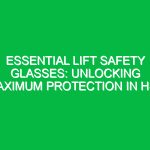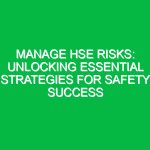Introduction
Hello team! Thank you for gathering today for this essential Toolbox Talk. Our focus will be on Struck-by Incidents (Construction), a critical topic in our Health, Safety, and Environment (HSE) practices. Understanding how to prevent these incidents is crucial as they are among the leading causes of injuries and fatalities on construction sites. By the end of this talk, you will have a solid grasp of how to recognize potential Hazards, implement preventive measures, and contribute to a safer working environment for everyone.
Understanding Struck-by Incidents
First, let’s define what we mean by Struck-by Incidents (Construction). These incidents occur when a worker is hit by a moving object, which can include tools, equipment, materials, or even vehicles. According to the Occupational Safety and Health Administration (OSHA), struck-by incidents account for a significant percentage of construction-related injuries and fatalities. Understanding the types of struck-by incidents is the first step in Prevention.
Types of Struck-by Incidents
- Struck-by moving vehicles: This includes workers being hit by trucks, forklifts, or other vehicles on site.
- Struck-by falling objects: This occurs when tools, materials, or debris fall from heights, striking workers below.
- Struck-by swinging objects: This includes incidents where equipment like cranes or excavators swing loads that can hit workers.
- Struck-by flying objects: This might involve objects that are propelled or thrown through the air, such as tools or debris during construction activities.
The Importance of Prevention
Preventing Struck-by Incidents (Construction) is vital not only for individual Safety but also for the overall health of our workplace. Every worker has the right to a safe work environment, and it’s our responsibility to ensure that we adhere to Safety protocols. Accidents can lead to severe injuries, financial losses, and even legal consequences for the company. Moreover, a culture of safety boosts morale and productivity, fostering a positive atmosphere for everyone.
Identifying Potential Hazards
Awareness is key in preventing struck-by incidents. Here are some common hazards you should be vigilant about:
- Worksite Layout: Poorly organized sites can increase the risk of collisions between workers and vehicles.
- Overhead Work: Workers need to be cautious of overhead work where materials may fall.
- Equipment Use: Operators must be trained and cautious when using heavy machinery to prevent swinging loads from striking others.
- Weather Conditions: Rain, wind, or ice can increase the likelihood of objects falling or being mismanaged.
Best Practices to Prevent Struck-by Incidents
To mitigate the risks of Struck-by Incidents (Construction), here are some Best Practices to follow:
1. Proper Training
All workers should undergo training on the specific risks associated with struck-by incidents. This includes understanding the dangers of working around moving vehicles and tools. Regular safety meetings should be held to reinforce these training sessions.
2. Use of Personal Protective Equipment (PPE)
Wearing appropriate PPE, such as hard hats, safety glasses, and high-visibility clothing, can significantly reduce the risk of injury. Ensure that your PPE is in good condition and fits properly.
3. Site Organization
Maintain a well-organized site. Clearly marked pathways for pedestrians and vehicles can help reduce the likelihood of accidents. Ensure that materials are stored securely and out of pathways.
4. Hazard Communication
Communicate hazards effectively. Use signs and barriers to alert workers about potential struck-by risks. Regularly remind the team about these hazards during Toolbox Talks.
5. Equipment Maintenance
Ensure that all equipment is well-maintained. Regular inspections and maintenance can prevent equipment failures that could lead to struck-by incidents.
Real-life Examples
Let’s consider a couple of real-life scenarios to illustrate the importance of awareness and prevention:
Scenario 1: Forklift Operations
Imagine a busy site where forklifts are moving materials. A worker, distracted and not wearing a high-visibility vest, steps into the path of a forklift. Fortunately, the operator is alert and stops in time, but this could have easily resulted in a serious injury. Always be aware of your surroundings and ensure visibility is prioritized.
Scenario 2: Falling Tools
In another instance, a worker is on a scaffold and accidentally drops a tool. Without a hard hat, a colleague below could suffer an injury. This scenario stresses the importance of wearing PPE and ensuring tools are secured when working at heights.
Regulations and Compliance
It’s important to understand that there are Regulations in place regarding Struck-by Incidents (Construction). osha outlines specific Standards that employers must follow to ensure safety on construction sites. Familiarize yourself with these regulations as they are designed to protect you and your coworkers. Compliance with these standards not only enhances safety but also fulfills legal obligations.
Engaging the Team
Now, I want to hear from you. What are some struck-by hazards you’ve encountered on site? How did you handle them? Sharing experiences can lead to valuable insights and reinforce our commitment to safety.
Conclusion
In summary, preventing Struck-by Incidents (Construction) is a collective effort that requires awareness, communication, and adherence to safety protocols. By identifying potential hazards, employing Best Practices, and engaging in ongoing training, we can create a safer work environment for everyone. Thank you for your attention and commitment to safety. Let’s keep each other safe out there!


